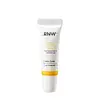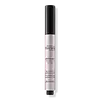What's inside
What's inside
 Key Ingredients
Key Ingredients

 Benefits
Benefits

 Concerns
Concerns

 Ingredients Side-by-side
Ingredients Side-by-side

Petrolatum
EmollientIsopropyl Palmitate
EmollientPolybutene
Caprylic/Capric Triglyceride
MaskingPentaerythrityl Tetraisostearate
EmollientPolyethylene
AbrasiveMicrocrystalline Wax
Emulsion StabilisingTocopheryl Acetate
AntioxidantButyrospermum Parkii Butter
Skin ConditioningSqualane
EmollientPanthenol
Skin ConditioningDiisostearyl Malate
EmollientAllantoin
Skin ConditioningSorbitan Sesquioleate
EmulsifyingPhenoxyethanol
PreservativeHydrogenated Vegetable Oil
EmollientPrunus Amygdalus Dulcis Oil
Skin ConditioningArgania Spinosa Kernel Oil
EmollientSimmondsia Chinensis Seed Oil
EmollientCamellia Sinensis Seed Oil
HumectantCamellia Japonica Seed Oil
EmollientOlea Europaea Fruit Oil
MaskingMacadamia Integrifolia Seed Oil
Skin ConditioningStearalkonium Hectorite
Gel FormingPropylene Carbonate
SolventCitrus Aurantium Dulcis Peel Oil
MaskingLimonene
PerfumingMonascus Extract
Skin ConditioningPalmitoyl Hexapeptide-12
Skin ConditioningTocopherol
AntioxidantWater
Skin ConditioningGlycyrrhetinic Acid
Skin Conditioning1,2-Hexanediol
Skin ConditioningSodium Hyaluronate
HumectantHydroxypropyltrimonium Hyaluronate
Hydrolyzed Hyaluronic Acid
HumectantSodium Acetylated Hyaluronate
HumectantHyaluronic Acid
HumectantPotassium Hyaluronate
Skin ConditioningSodium Hyaluronate Crosspolymer
HumectantPetrolatum, Isopropyl Palmitate, Polybutene, Caprylic/Capric Triglyceride, Pentaerythrityl Tetraisostearate, Polyethylene, Microcrystalline Wax, Tocopheryl Acetate, Butyrospermum Parkii Butter, Squalane, Panthenol, Diisostearyl Malate, Allantoin, Sorbitan Sesquioleate, Phenoxyethanol, Hydrogenated Vegetable Oil, Prunus Amygdalus Dulcis Oil, Argania Spinosa Kernel Oil, Simmondsia Chinensis Seed Oil, Camellia Sinensis Seed Oil, Camellia Japonica Seed Oil, Olea Europaea Fruit Oil, Macadamia Integrifolia Seed Oil, Stearalkonium Hectorite, Propylene Carbonate, Citrus Aurantium Dulcis Peel Oil, Limonene, Monascus Extract, Palmitoyl Hexapeptide-12, Tocopherol, Water, Glycyrrhetinic Acid, 1,2-Hexanediol, Sodium Hyaluronate, Hydroxypropyltrimonium Hyaluronate, Hydrolyzed Hyaluronic Acid, Sodium Acetylated Hyaluronate, Hyaluronic Acid, Potassium Hyaluronate, Sodium Hyaluronate Crosspolymer
Phytosteryl/Isostearyl/Cetyl/Stearyl/Behenyl Dimer Dilinoleate
Skin ConditioningSqualane
EmollientTriethylhexanoin
MaskingCaprylic/Capric Triglyceride
MaskingDiisostearyl Malate
EmollientMica
Cosmetic ColorantPolyethylene
AbrasiveDipentaerythrityl Hexahydroxystearate/Hexastearate/Hexarosinate
Skin ConditioningHydrogenated Polyisobutene
EmollientCetearyl Ethylhexanoate
EmollientStearyl Heptanoate
EmollientPhytosteryl Isostearyl Dimer Dilinoleate
EmollientStearalkonium Hectorite
Gel FormingSorbitan Sesquioleate
EmulsifyingHdi/Trimethylol Hexyllactone Crosspolymer
Microcrystalline Wax
Emulsion StabilisingEthylhexyl Palmitate
EmollientIsopropyl Palmitate
EmollientPropylene Carbonate
Solvent1,2-Hexanediol
Skin ConditioningQuaternium-18 Bentonite
Tocopheryl Acetate
AntioxidantTribehenin
EmollientCaprylyl Glycol
EmollientDimethicone
EmollientEthylhexylglycerin
Skin ConditioningSorbitan Isostearate
EmulsifyingSilica
AbrasiveBorago Officinalis Seed Oil
EmollientHelianthus Annuus Seed Oil
EmollientLinum Usitatissimum Seed Oil
PerfumingPrunus Amygdalus Dulcis Oil
Skin ConditioningTocopherol
AntioxidantSilica Dimethyl Silylate
EmollientButylene Glycol
HumectantPalmitoyl Tripeptide-1
Skin ConditioningHexylene Glycol
EmulsifyingSodium Hyaluronate
HumectantPhenoxyethanol
PreservativePhytosteryl/Isostearyl/Cetyl/Stearyl/Behenyl Dimer Dilinoleate, Squalane, Triethylhexanoin, Caprylic/Capric Triglyceride, Diisostearyl Malate, Mica, Polyethylene, Dipentaerythrityl Hexahydroxystearate/Hexastearate/Hexarosinate, Hydrogenated Polyisobutene, Cetearyl Ethylhexanoate, Stearyl Heptanoate, Phytosteryl Isostearyl Dimer Dilinoleate, Stearalkonium Hectorite, Sorbitan Sesquioleate, Hdi/Trimethylol Hexyllactone Crosspolymer, Microcrystalline Wax, Ethylhexyl Palmitate, Isopropyl Palmitate, Propylene Carbonate, 1,2-Hexanediol, Quaternium-18 Bentonite, Tocopheryl Acetate, Tribehenin, Caprylyl Glycol, Dimethicone, Ethylhexylglycerin, Sorbitan Isostearate, Silica, Borago Officinalis Seed Oil, Helianthus Annuus Seed Oil, Linum Usitatissimum Seed Oil, Prunus Amygdalus Dulcis Oil, Tocopherol, Silica Dimethyl Silylate, Butylene Glycol, Palmitoyl Tripeptide-1, Hexylene Glycol, Sodium Hyaluronate, Phenoxyethanol
Ingredients Explained
These ingredients are found in both products.
Ingredients higher up in an ingredient list are typically present in a larger amount.
1,2-Hexanediol is a synthetic liquid and another multi-functional powerhouse.
It is a:
- Humectant, drawing moisture into the skin
- Emollient, helping to soften skin
- Solvent, dispersing and stabilizing formulas
- Preservative booster, enhancing the antimicrobial activity of other preservatives
This ingredient is an emollient, solvent, and texture enhancer. It is considered a skin-softener by helping the skin prevent moisture loss.
It helps thicken a product's formula and makes it easier to spread by dissolving clumping compounds.
Caprylic Triglyceride is made by combining glycerin with coconut oil, forming a clear liquid.
While there is an assumption Caprylic Triglyceride can clog pores due to it being derived from coconut oil, there is no research supporting this.
Learn more about Caprylic/Capric TriglycerideDiisostearyl Malate is an emollient and most often used in lip products. It comes from isostearyl alcohol, a fatty acid, and malic acid, an AHA.
As an emollient, Diisostearyl Malate helps create a thin film on your skin to trap moisture in. This helps keep your skin soft and smooth.
Isopropyl Palmitate is a texture enhancer and emollient. It is an ester of isopropyl alcohol and palmitic acid.
Palmitates are emollients. Emollients help keep your skin soft and smooth by creating a barrier that traps moisture in.
When added to cosmetics, Isopropyl Palmitate creates a silky texture and improves spreadability.
Isopropyl Palmitate may not be fungal acne safe. It can worsen acne prone skin.
Learn more about Isopropyl PalmitateMicrocrystalline Wax is created by de-oiling petroleum. It is highly refined and purified before being added to cosmetics.
Microcrystalline Wax is used to enhance the texture and create even consistency. It helps stabilize a product by preventing ingredients from separating.
Phenoxyethanol is a preservative that has germicide, antimicrobial, and aromatic properties. Studies show that phenoxyethanol can prevent microbial growth. By itself, it has a scent that is similar to that of a rose.
It's often used in formulations along with Caprylyl Glycol to preserve the shelf life of products.
Polyethylene is a synthetic ingredient that helps the skin retain moisture. It is a polymer.
It is also typically used within product formulations to help bind solid ingredients together and thicken oil-based ingredients. When added to balms and emulsions, it helps increase the melting point temperature.
This ingredient is a solvent. It helps dissolve active ingredients and alter the texture of products.
Propylene Carbonate is commonly used in makeup and with clay, such as montmorillonite or bentonite.
Studies show this ingredient to be safe for cosmetics. When it is undiluted, it can cause skin irritation. (It is always diluted in skincare and makeup). This ingredient is water-soluble.
Propylene Carbonate is created from propylene glycol and carbonic acid.
Learn more about Propylene CarbonatePrunus Amygdalus Dulcis Oil comes from the sweet almond, a tree native to Iran. This oil has no fragrance and is non-volatile.
Almonds contain healthy fats, vitamins, and minerals. It is a rich source of Vitamin E, a great antioxidant and skin conditioning ingredient. Sweet almond oil contains fatty acids such as linolenic acid and triglycerides.
The content of sweet almond oil makes it a great emollient; it can help soften and hydrate your skin. Emollients create a barrier over your skin to trap moisture in. Sweet almond oil has antioxidant properties.
Those with an almond allergy should be careful of this ingredient and speak with a professional about using it in your skincare.
This ingredient may not be fungal-acne safe.
Learn more about Prunus Amygdalus Dulcis OilSodium Hyaluronate is hyaluronic acid's salt form. It is commonly derived from the sodium salt of hyaluronic acid.
Like hyaluronic acid, it is great at holding water and acts as a humectant. This makes it a great skin hydrating ingredient.
Sodium Hyaluronate is naturally occurring in our bodies and is mostly found in eye fluid and joints.
These are some other common types of Hyaluronic Acid:
Learn more about Sodium HyaluronateSorbitan Sesquioleate is derived from sorbitol and oleic acid. It is an emulsifier and prevents ingredients from separating.
Specifically, this ingredient is a water-in-oil emulsifier, meaning it helps water dissolve into oil.
Some studies suggest this ingredient may cause irritation in some people. If you are unsure, it is best to patch test.
This ingredient may not be Malassezia folliculitis, or fungal-acne safe.
Learn more about Sorbitan SesquioleateSqualane is an emollient that helps the skin hold onto moisture. It's an oily liquid that occurs naturally in certain types of fish and plant oils.
Because squalane boosts hydration in the skin, it also comes with plenty of benefits: it is an antioxidant and can help fight free radicals and skin damage. Squalane is also found to have a detoxifying effect when applied.
Squalane comes from squalene, which occurs naturally within the sebum of our skin. It is one of the oils our skin produces to keep itself hydrated. Squalane is the hydrogenated version of squalene and has a longer shelf life.
Research shows that squalane is non-irritating (even at 100% concentration).
In general, it's a fantastic ingredient. It does a great job at hydrating the skin, and it's suitable for those with sensitive skin.
The source of squalane may impact malassezia / fungal acne. This is because olive oil derived squalane can contain impurities such as fatty acids and plant waxes. Sugarcane derived squalane is recommended for anyone with malassezia concerns.
Is squalane vegan?
This depends on the source. Squalane can be derived from both plants and animals. Most squalane used in skincare comes from plants.
Please note: the source of squalane is only known if disclosed by the brand. We recommend reaching out to the brand if you have any questions about their squalane.
Read more about squalene with an "e".
Is squalane an oil?
Squalane is often called an oil, but it’s technically not; it’s a hydrocarbon, meaning it’s only made of carbon and hydrogen, unlike true oils which are triglycerides made of fatty acids and glycerol.
The term “oil-free” isn’t regulated, so companies can define it however they want. Some exclude all oils, while others just avoid mineral oil or comedogenic oils.
While some people avoid oils thinking they cause breakouts, the right kind of oil (or oil-like ingredient like squalane) can actually help balance and hydrate your skin. It’s worth testing out simple oils or squalane to see what works best for your skin.
Learn more about SqualaneStearalkonium Hectorite is a clay-derived ingredient used to thicken a product and help create a gel-like texture.
Tocopherol (also known as Vitamin E) is a common antioxidant used to help protect the skin from free-radicals and strengthen the skin barrier. It's also fat soluble - this means our skin is great at absorbing it.
Vitamin E also helps keep your natural skin lipids healthy. Your lipid skin barrier naturally consists of lipids, ceramides, and fatty acids. Vitamin E offers extra protection for your skin’s lipid barrier, keeping your skin healthy and nourished.
Another benefit is a bit of UV protection. Vitamin E helps reduce the damage caused by UVB rays. (It should not replace your sunscreen). Combining it with Vitamin C can decrease sunburned cells and hyperpigmentation after UV exposure.
You might have noticed Vitamin E + C often paired together. This is because it is great at stabilizing Vitamin C. Using the two together helps increase the effectiveness of both ingredients.
There are often claims that Vitamin E can reduce/prevent scarring, but these claims haven't been confirmed by scientific research.
Learn more about TocopherolTocopheryl Acetate is AKA Vitamin E. It is an antioxidant and protects your skin from free radicals. Free radicals damage the skin by breaking down collagen.
One study found using Tocopheryl Acetate with Vitamin C decreased the number of sunburned cells.
Tocopheryl Acetate is commonly found in both skincare and dietary supplements.
Learn more about Tocopheryl Acetate